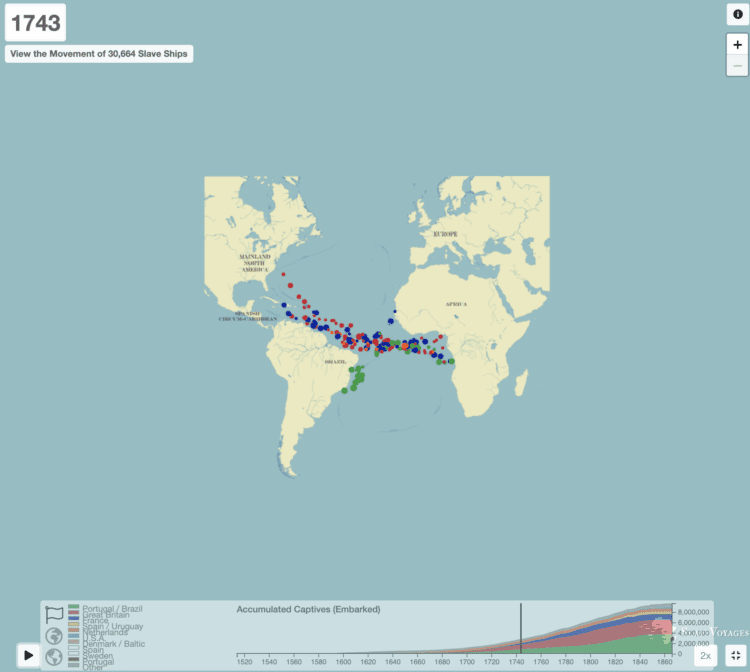I have the honor of teaching African American Studies at my high school. As a white middle age male, it’s not a duty I take lightly. I have an obligation to my students, the community, and myself to honor the lives that comprise the field of study. While I can’t teach the experience, I can damn well do my best to ensure the history of Black Americans is taught honestly. When it comes to the Transatlantic Slave Trade I rely heavily on the on the Transatlantic Slave Database at Slavevoyages.org.
The Transatlantic Slave Database as an Educational Tool
In the realm of teaching African American history, educators face the formidable task of conveying the extensive and often overwhelming data. They must also simultaneously encapsulating the deeply personal and human stories of individuals. Because people treated enslaved individuals as property, there exists a lot of data cataloging them in this manner. This leaves them nameless and without a voice. This challenge is particularly acute when discussing the intricate and sorrowful narrative of the Transatlantic slave trade. Here, the Transatlantic Slave Database is instrumental, providing a rich blend of quantitative data and qualitative insights. Thoughtful integration of the database with primary sources and modern poetry significantly enhances students’ comprehension and empathy.

The Transatlantic Slave Database transcends its function as a mere collection of statistics. It serves as a vital conduit to understanding one of the most profound and distressing migrations in human history. Cataloguing nearly 36,000 voyages that forcibly moved over 12 million Africans to the Americas, the database lays the groundwork for a comprehensive examination of the slave trade. Teaching students to navigate this resource cultivates essential skills in data analysis and digital research, crucial in today’s digital era. More critically, it empowers them to scrutinize and interpret historical data, unveiling the narratives behind the numbers. With it’s wonderful use of maps and animations, it explains the scope of the human trafikking of Africans and illsustrates how it doeminated all of the Atlantic.
From Numbers to Narratives

While the database equips students with an understanding of the slave trade’s magnitude, it’s the journey from quantitative data to individual stories that truly deepens their learning. The depiction of millions of individuals as mere data points demands a closer look at the personal experiences within those numbers. This examination is enriched through the narratives of Olaudah Equiano and Venture Smith. Their autobiographies provide more than just context; they breathe life into the figures, revealing the resilience, anguish, and unyielding spirit of those who survived enslavement.
Adding Depth with Primary Sources
The personal accounts of Equiano and Smith are powerful tools for teaching. They allow students to connect emotionally and intellectually with individuals from the past, bridging centuries of separation. Educators can incorporate these narratives into lessons that focus on the database. This fosters a learning environment where empathy and analysis coexist. Students learn to look beyond the numbers. They recognize the impact of the slave trade on real lives. They also understand the lasting legacies of those experiences.
Modern Voices: The Role of Poetry
Poetry by figures like Robert Hayden further deepens this connection, linking past and present through the emotive power of verse. Hayden’s poems, such as “Middle Passage,” articulate the collective memory and ongoing trauma of the African diaspora, offering reflections that are as relevant today as they were decades ago. By engaging with these modern interpretations, students can appreciate the continuity of history and its reverberations in contemporary society. Poetry becomes a lens through which the data’s emotional and human dimensions are magnified, making the historical personal and accessible. Hayden’s verse gives voice to all people involved in the trade and forces the reader to confront the harsh realities of the voyage.
Classroom Implementation
Integrating the Transatlantic Slave Database, primary sources, and poetry into the curriculum can be done through various interactive projects and assignments. For example, students could create digital storytelling projects that combine data analysis with personal narratives or compose their own poems reflecting on the human stories behind the database figures. Discussion prompts that encourage students to reflect on the interconnectedness of data, personal narratives, and poetry can stimulate critical thinking and empathy. The website itself offers some excellent lesson plans which I incorporate into my lessons.
Final Thoughts on the Transatlantic Slave Database
Educators can integrate the Transatlantic Slave Database, primary sources, and poetry into the curriculum through various interactive projects and assignments. Through the Transatlantic Slave Database, paired with the poignant narratives of Olaudah Equiano and Venture Smith, and the reflective verse of poets like Robert Hayden, educators can offer a more nuanced, empathetic, and comprehensive exploration of the African American experience.
As we strive to understand our past and its impact on our present and future, let us remember the power of education to bridge data and humanity. In doing so, we honor the memories of those who came before us and empower our students to build a more empathetic and informed world.
Click here to see our other teaching blogs!
About The Author
Discover more from NolaNerdCouple.com
Subscribe to get the latest posts sent to your email.




